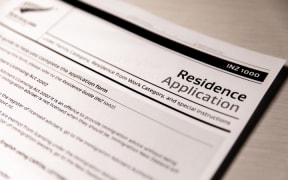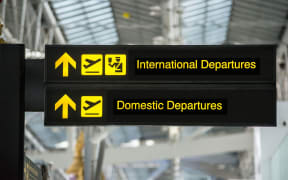Software which can help process visa applications stops short of making decisions about which migrants are allowed into the country, says Immigration New Zealand (INZ).

The associate director of the Refugee Law Lab at York University in Canada, Petra Molnar, says in the rush to improve the efficiency of visa processing, New Zealand seems to have skipped the debate about whether using the software is the right thing to do. Photo: Supplied
New rules allow electronic systems to grant visitor visas and to grant or refuse interim visas, which are used to keep people lawfully in the country while another visa is being decided.
But the government agency is insisting it will not use the powers, intending only to use the technology to perform administrative tasks.
Immigration lawyer Aaron Martin said with big workloads some automation made sense for faster decisions, but there were reasons for concern.
"One of the advantages, of course, is speed - in the sense that there shouldn't be a need for a cumbersome search of documentation, as I understand the system will be able to essentially read all of that and basically only be in the position to sort of trigger human intervention at various points if that is necessary.
"Having said that, it's remarkable how INZ has been able to defeat the advances of the 21st century in terms of tech, so it will depend on the degree to which they use it and how they use it, and whether they use it to best effect for either service delivery, or alternatively for their own internal benefits," he said.
"The concern that I think most people have is if you're going to automate the decisions, then how on earth are the decisions going to be formulated other than simply as a result of a template?
"And if you want to know what the reasons are, or what the assessment was or how the assessment was conducted, how the documentation was viewed - there can't really be any sort of assessment that's intelligible if it's done by algorithms. So it kind of reduces the whole process down to a checkbox exercise, where there's no sort of ability to persuade or convince or make a case, or very limited elements of it."
A 2018 government report detailed how INZ uses operational algorithms to manage risk and speed up decisions, including biometric and biographic matching, screening and case prioritising.
INZ had also created a data modelling trial using a points matrix at its weekly meeting to prioritise cases for action, using Indians as one of its criteria for deporting offenders.
It was scrapped, with the Human Rights Commission and Privacy Commissioner saying they would work with INZ if it wanted to ever look at a similar initiative.
Professor Colin Gavaghan, of Otago University, said at the time that studies on human interactions with technology and algorithms suggested people tended to defer to whatever the machine recommended, even if the decision rested with them.
It's a concern Martin echoes, saying migrants' demographics dictate the risk rating their application has before an immigration officer looks at it, and further automation could make that worse.
"We all know that it exists, we all know that if you have a certain profile in terms of your age, your marital status, your education background and the country you come from, the prospect of you getting a general visitor visa is zero and your advice to people is 'look, don't even bother applying'.
"So, for me, if they carry that forward into an automated system then it means they are actually building into the system bias and that comes back to that issue of ... how do you get to convince anyone of your case if it's been done by algorithmic formula."
International students and applicants for the new accredited work visas can use the enhanced Immigration Online system later this year.
Eventually all visa types will go through that system, though the option to use paper applications is being kept for now.
Concerns about gradually widening the scope of automation have surfaced in other countries that belong to the Migration 5, a forum which mirrors membership of the Five Eyes intelligence alliance.
The associate director of the Refugee Law Lab at York University in Canada, Petra Molnar, researches how surveillance, artificial intelligence, profiling and automation is used in border decisions.
She said in the rush to improve efficiency, New Zealand seemed to have skipped the debate about whether it was the right thing to do.
"It immediately kind of highlighted that there is a lack of just a conversation around oversight, accountability and the kind of impact this can have on people's applications, but also just their human rights generally," she said.
"For example, freedom from discrimination, equality rights, but also people's right to privacy and even just basic transparency and procedural rights. Oftentimes, we don't even know that governments are doing this.
"And the concern with these technologies is because they lack transparency - and oftentimes it's really hard to know how a decision is arrived at because when we're talking about, for example, algorithms and automated decision making - it's very difficult to actually get out why a particular decision was rendered, what kind of risk factors were assessed, what kind of information was collected. It basically just creates a really high-risk environment for the individual at stake and also in terms of just their procedural rights.
"The concern is that when we're introducing either augmented or fully automated decision-making into something as opaque and discretionary as immigration decisions, basically the technology we know is not bias-free, and it can not only replicate the kind of biases that we hold in society, but also create new ones."
INZ said new technology would automate the application process, improve the customer experience and speed up decisions - but not make the decisions without human input.
A national manager at INZ, Jeannie Melville, said artificial intelligence was not being used.
The rule change was signed off by the minister based on legislation that allowed automated decision-making.
"There's nothing at all which enables us to automatically decline a visa application, this is only about automating the approval of certain components of the application. So with the visitor visa at the moment, we're not doing any end-to-end automation. It's only certain components that can be automated.
"As we introduce the system, an immigration officer will be looking at every single application," she said.
"Now if there's any issue with an interim visa, for example, if a previous visa had any character issues or health issues or anything that needed to be revisited, that would always drop out for an immigration officer to look at and use their expertise to determine whether it should be granted or not."
The 2018 report said three-quarters of agencies provided some description of the operational algorithms they used on their websites, but no such information could be found during a keyword search on the INZ site.
It noted risk rule changes were overseen by a tiered governance model a Triage Reference Group, Operational Systems Integrity Committee (OSIC) and the Immigration Leadership Team.
General manager of enablement Stephen Dunstan said OSIC was no longer in existence but a Data Science Review Board oversaw the development and use of algorithms by INZ and the Ministry of Business, Innovation and Employment as a whole. It included independent external members and had been updated about the changes to Immigration Online.
Automating administrative steps for visa applications was not the same as decision making and only immigration officers could decline applications, he said.
"We always assess information provided by the applicant before a decision is made on an application, but the improvements to our online systems are designed to make it easier to apply for a visa and improve visa processing times. For example, if a photo submitted as part of the online application meets requirements the applicant will automatically be moved onto the next stage of the application, similar to an online application for a New Zealand passport.
"We manage the collection, storage, use, and handling of an individual's data in accordance with the Privacy Act 2020."
A Privacy Impact Assessment had been prepared as part of the development of Immigration Online and no significant concerns were raised by the Privacy Commissioner, he said.
Verification tools also being introduced include a global address finder, photo-quality checker, and a passport eChip verification mobile app.
Applicants will be told what evidence they need to submit at the time of application, with medical certificates requested after that, if need be. Sponsors and supporting partners will also be able submit declarations online.






